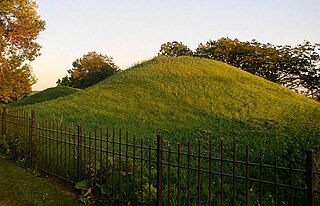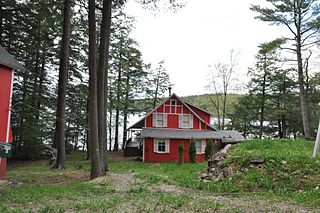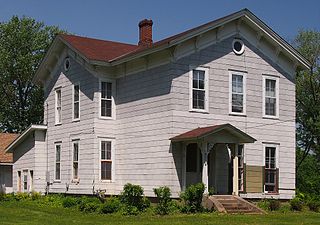
Detroit Lakes is a city in the State of Minnesota and the county seat of Becker County. The population was 9,869 at the 2020 census. Its unofficial population during summer months is much higher, estimated by citizens to peak at 13,000 midsummer, due to seasonal residents and tourists.

Lake Minnetonka is a lake located approximately 15 miles (24 km) west-southwest of Minneapolis, Minnesota. Lake Minnetonka has about 23 named bays and areas. The lake lies within Hennepin and Carver counties and is surrounded by 13 incorporated municipalities. At 14,528 acres (5,879 ha), it is Minnesota's ninth largest lake. It is a popular spot for local boaters, sailors, and fishermen.

The Como-Harriet Streetcar Line (CHSL) is a heritage streetcar line in Minneapolis, Minnesota, which follows original streetcar right-of-way between Lake Harriet and Bde Maka Ska and is operated by the Minnesota Streetcar Museum. The heritage line was originally developed in the 1970s by the Minnesota Transportation Museum which spun off streetcar operations in the winter of 2004-2005.

Lake Harriet is a lake in the southwest part of Minneapolis, just south of Bde Maka Ska and north of Minnehaha Creek. The lake is surrounded by parkland as part of the Minneapolis Chain of Lakes. The lake has an area of 335 acres (1.36 km2) and a maximum depth of 85 feet (26 m).

The Midtown Exchange is a historic structure and mixed-use building located in the Midtown neighborhood of Minneapolis, Minnesota, United States. It is the second-largest building in Minnesota in terms of leasable space, after the Mall of America. It was built in 1928 as a retail and mail-order catalog facility for Sears, which occupied it until 1994. It lay vacant until 2005, when it was transformed into multipurpose commercial space. The building is listed on the National Register of Historic Places as the Sears, Roebuck and Company Mail-Order Warehouse and Retail Store.

The Woodbury Fisk House is a historic house in the Marcy-Holmes neighborhood of Minneapolis, Minnesota, United States, built in 1869. It was listed on the National Register of Historic Places in 1983 for having local significance in the theme of architecture. It was nominated for being the most elaborate example of Italianate architecture—and one of the style's most intact specimens—in the city of Minneapolis.

Dayton's Bluff is a neighborhood located on the east side of the Mississippi River in the southeast part of the city of Saint Paul, Minnesota which has a large residential district on the plateau extending backward from its top. The name of the bluff commemorates Lyman Dayton, for whom a city in Hennepin County was also named. On the edge of the southern and highest part of Dayton's bluff, in Indian Mounds Park, is a series of seven large aboriginal mounds, 4 to 18 feet high, that overlook the river and the central part of the city.

The Milwaukee Avenue Historic District is a historic district in the Seward neighborhood of Minneapolis. The district comprises two city blocks of small homes on quarter-sized lots. These houses were built between 1884 and 1890 by William Ragan, a Minneapolis real estate speculator. Built for lower-income residents, the houses had deteriorated in condition by the end of World War II, and by the 1970s, were planned for demolition. A group of residents and concerned citizens fought to save the houses, eventually leading to their inclusion on the National Register of Historic Places and the federal protection and rehabilitation that comes with the designation. Today, the houses sit along a bike- and pedestrian-friendly mall on which motor traffic is prohibited.

The Crane Island Historic District is a historic district of vacation properties on Crane Island in Lake Minnetonka, part of the city of Minnetrista, Minnesota, United States. It consists of a number of private residential summer cottages and some communal amenities. Although it was originally developed by parishioners of the Presbyterian Church, it is now a secular association that welcomes all. The island was designated a historic district and listed on the National Register of Historic Places in 1991.

Linden Hills Library is a public library in the Linden Hills neighborhood of southwest Minneapolis, Minnesota, United States. The branch library originally opened in 1911 on the first floor of the Lake Harriet Commercial Club building. In 1931, under the leadership of Minneapolis Public Library's chief librarian Gratia Countryman, the library moved into its own building on 2900 West 43rd Street. Area resident Joseph Victor Vanderbilt designed the library in the Tudor Revival style. Head librarian Edith Frost served for over thirty years. The library has also hosted community groups such as children's clubs, neighborhood groups, and women's organizations. The library was listed on the National Register of Historic Places in 2000 and renovated in 2002.

The E.S. Hoyt House is a historic house in Red Wing, Minnesota, United States, designed by the firm of Purcell & Elmslie and built in 1913. The house is listed on the National Register of Historic Places. It is also a contributing property to the Red Wing Residential Historic District.

The George W. Baird House is a house in Edina, Minnesota, United States, built in 1886 by a prominent farmer in the Edina Mills community. The house was originally part of a 120-acre (49 ha) farmstead. The house was listed on the National Register of Historic Places in 1980 for having local significance in architecture, agriculture, and settlement.

The Bemidji Carnegie Library is a former library building in Bemidji, Minnesota, United States. It was built as a Carnegie library in 1909 and housed the city's public library until 1961. It was listed on the National Register of Historic Places in 1980 for its local significance in the themes of architecture and education. It was nominated for being a well-preserved example of a Carnegie library and of public Neoclassical architecture.

The Sunset Beach Hotel, also referred to as Peters' Sunset Beach Resort, is a historic resort hotel in Glenwood Township, Pope County, Minnesota, 5 miles (8.0 km) southwest of Glenwood, United States. Situated on the southern shore of Lake Minnewaska, three structures of the private, commercial resort were placed on the National Register of Historic Places (NRHP) on February 11, 1982. The complex is notable because it stands as one of the best-preserved early resorts in west central Minnesota, and as a center of seasonal resort activity on the lake since the second decade of the twentieth century.

The Silver Lake District is a historic district encompassing a summer resort area along the southern section of Silver Lake in Harrisville, New Hampshire. It includes a collection of summer cottages built along or near the shores of the lake between about 1880 and 1903, a period of prosperity in Harrisville and nearby Keene. It is unusual in that most of the owners and occupants of its properties were from nearby towns, and not from further afield, as the populations of the summer colonies of Nelson and Dublin were. The district covers 66 acres (27 ha) from the town line between Harrisville and Nelson to the southern end of the lake, and includes 76 contributing buildings. It was listed on the National Register of Historic Places in 1986.

The Kineo Cottage Row Historic District encompasses a collection of seven summer resort cottages on the Mount Kineo peninsula, which juts into Moosehead Lake in the central Maine. The cottages were built between 1900 and 1912 as part of the Mount Kineo resort complex, one of interior Maine's most successful summer resorts of the early 20th century, and are its only major surviving component. The cottages were listed on the National Register of Historic Places in 2004.

The Mortimer Webster House is a historic house in Stillwater, Minnesota, United States, constructed 1865–1866. It is listed on the National Register of Historic Places in 1982 for having local significance in the themes of architecture and commerce. It was nominated for being one of the best examples of Italianate architecture in Stillwater, and for its association with Mortimer Webster, one of the town's notable early entrepreneurs.

The John P. Furber House is a historic house in Cottage Grove, Minnesota, United States, built in 1871, the same year Furber officially platted the 20-year-old settlement. It was listed on the National Register of Historic Places in 1982 for having local significance in the theme of community planning and development. It was nominated for its association with the phenomenon in early Washington County towns of platting well after communities had already been established.
Liebenberg and Kaplan (L&K) was a Minneapolis architectural firm founded in 1923 by Jacob J. Liebenberg and Seeman I. Kaplan. Over a fifty-year period, L&K became one of the Twin Cities' most successful architectural firms, best known for designing/redesigning movie theaters. The firm also designed hospitals, places of worship, commercial and institutional buildings, country clubs, prestigious homes, radio and television stations, hotels, and apartment buildings. After designing Temple Israel and the Granada Theater in Minneapolis, the firm began specializing in acoustics and theater design and went on to plan the construction and/or renovation of more than 200 movie houses throughout Minnesota, North and South Dakota, Iowa, and Wisconsin. Architectural records, original drawings, and plans for some 2,500 Liebenberg and Kaplan projects are available for public use at the Northwest Architectural Archives.

The Ottawa Beach Historic District is a residential historic district located on Ottawa Beach Road in Park Township, Ottawa County, Michigan near the outlet of Lake Macatawa. It was listed on the National Register of Historic Places in 1995.























